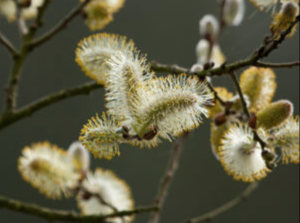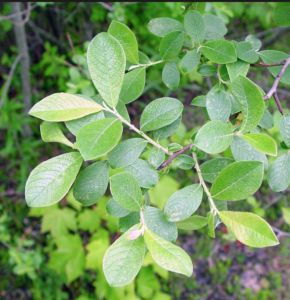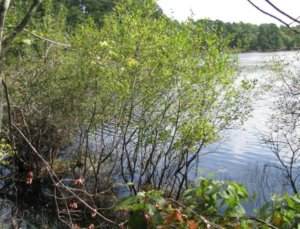Common Name: Gray Willow
Specific Name: Salix cinerea
Known Occurrence at Taylor Point:
Map areas: Woodlands 3A, Woodlands 3B, Woodlands 3C
Category: Invasive, Non-Native, Shrub

Ecological Considerations:
Salix cinerea is a is a slender tree-like shrub that can reach heights of 30 feet. It is generally branched from the base but also can form a single trunk. Its leaves are shiny on the upper surface, bearing soft grey hairs on the underside. Its distinctive catkins, or flowers, appear before the leaves in spring.
The gray willow’s flowers are dioecious (individual flowers are either male or female, but only one sex is to be found on any one plant) The male catkins emerge as silvery. They turn yellow as pollen is released. The female catkins are greenish-grey, maturing in early summer, releasing tiny seeds embedded in white cottony down which aids in wind dispersal. Gray willow also is pollinated by insects. The plant is not self-fertile.
Salix cinerea readily colonizes wetlands. It has an extensive root system and thrives in both disturbed and undisturbed land. It grows in wet or even flooded soils and can tolerate permanent water logging.
Problems Posed by this Plant:
Gray willow can form dense thickets, thus crowding out and out-competing native species.
Native Species Affected by this Plant:
Factors Affording a Competitive Advantage to this Plant:
Salix cinerea shrubs/trees have extensive root systems. Roots will grow readily from hanging branches ( layering ) as well as from small fragments left on the wet ground or even flowing in shallow water. The gray willow spreads rapidly and aggressively owing to its intensive water demands, often outcompeting other native species for available water. Plants growing beneath the willow’s dense leaf cover also will likely be shaded out and will die.
Propagation Mechanisms and Related Issues Affecting Efforts to Remove and/or Eliminate this Plant from Taylor Point:
Gray Willows produce large numbers of wind-blown seeds that spread widely.
Gray Willows also spread via root suckers. With its extensive root system, Gray Willow can also root easily from branches that touch the ground, and can form dense root-mats on the surface of the soil or in shallow or slow moving water.
Documented Best Removal Practices and Options/Pros and Cons of Various Options:
The most effective removal method is to manually remove the plants, taking as much of the root system as possible. Hand-pulling must be thorough and repeated often. A weed wrench will be helpful in removing larger plants. Persistent cutting of the shoots will help to eventually kill the plant.
Survey the site in mid-March to late May to identify potential seed sources. Collect catkins which flower before the plant’s leaves emerge.
If trees are cut down, take care to prevent broken branches from being pushed into the ground during tree removal to prevent emergence of new plants. Remove live trunks and limbs from the site and stack them to dry above flood level. Take care to minimize the spread of small pieces. Smaller twigs should be bagged and disposed offsite. If he complete removal of a stump is not possible, cover the stump with Buckthorn Baggies or a thick black plastic bag.
Follow-up monitoring and control should be continued for 3 to 5 year or more.
Case Studies of Removal Efforts, Lessons Learned and Recommendations:
Additional Photos:



Sources cited:
National Wildlife Refuge Early Detection Network for New England
Plants for a Future
Wiki Gray Willow
Orleans Conservation Trust
Go Botany
Suzanne Enser, TPRA CRMC Permit Request Support paper
Key Words:
Shrub;
Gray Willow
Salix cinerea
Seed – Berries / Drupes;
Vegetative – layering
Black Cherry Woodland
3A, 3B, 3C
